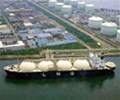US Gulf Coast LNG terminals make preparations for approaching tropical storms

US LNG production remained steady Aug. 24 as two tropical storms approached the Gulf Coast, threatening a wide swath of Louisiana and Texas with heavy rain and wind.
Terminals were preparing for the possibility of curtailing operations and issuing shelter-in-place orders to employees, depending on the trajectory and intensity of the storms.
The rare one-two storm punch was expected to have little overall impact on the global LNG market, according to multiple trading sources. This was due to the pervading low rate of cargo loadings from US Gulf Coast-based facilities that have been driven by cargo cancellations throughout the summer.

Low international prices and weak demand exacerbated by the coronavirus pandemic prompted a significant drop in gas deliveries to US LNG export facilities starting in April. Flows recovered in recent weeks amid a rebound in netbacks to Asia, though that could reverse again at least temporarily with Laura and Marco approaching the Gulf Coast. Total US flows stood at almost 5.1 Bcf/d on Aug. 24, an increase of over 100 MMcf/d from the day before and a slight decrease from Aug. 21.
Cheniere Energy’s Sabine Pass and Sempra Energy’s Cameron LNG, both in southwest Louisiana, were expected to face the biggest impact, based on the latest forecast tracks for the storms. Based on flows, neither facility appeared to be taking any immediate steps to cut production or otherwise reduce operations.
“It all depends on the track of the storm,” Cameron LNG spokeswoman Anya McInnis said.
She said the terminal south of Lake Charles would use a phased approach to managing operations through the storms, based in part on the intensity of wind.
“Safety of cargo loading operations and status of the Calcasieu Channel will determine impacts, if any, on the production and loading schedules,” McInnis said.
Cheniere officials did not immediately respond to several messages seeking comment on any plans for adjustments at Sabine Pass. Cheniere’s export terminal near Corpus Christi, Texas, did not appear likely to be impacted by either storm, based on the latest forecasts.
In Texas, Freeport LNG, south of Houston, was actively monitoring the forecast tracks of the storms and has taken steps to secure the site, spokeswoman Heather Browne said. She did not address when or if production would be reduced. Gas deliveries to the facility were above 400 MMcf/d on Aug. 24, at a similar level as each day over the previous week.
Tanker activity
Cargoes have been loading in August from the four facilities in the Gulf region at a rate of just over one cargo per day, or at a gas equivalent of about 3.55 Bcf/d, S&P Global Platts Analytics data show. That is well below loading rates of around 8 Bcf/d or higher seen in the first quarter of 2020.
As of late morning Aug. 24, there were five LNG vessels in the Gulf of Mexico, with only one vessel, the Bonito LNG, heading toward the US coast, according to Platts trade-flow software cFlow. The other four vessels were making their way out of the Gulf after each loaded at one of the four USGC-based facilities.
August-loading cargoes out of the USGC were no longer under assessment, however, the value of the Platts Gulf Coast Marker for H1 September was last marked at $2.825/MMBtu on Aug. 21, with markets in Northeast Asia providing the best value on a netback basis.
Source: Platts

 Hellenic Shipping News Worldwide Hellenic Shipping News Worldwide, Online Daily Newspaper on Hellenic and International Shipping
Hellenic Shipping News Worldwide Hellenic Shipping News Worldwide, Online Daily Newspaper on Hellenic and International Shipping





















 PG-Software
PG-Software